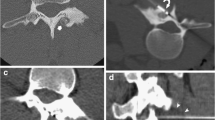Abstract
Purpose
To evaluate complications associated with cryoablation in a pediatric population and review preventive measures to mitigate these complications.
Material and Methods
Retrospective study including all the image guided cryoablations performed on pediatric population. Immediate and delayed complications were analyzed, and we identified the different protective measures used and the clinical outcomes from follow-up. Point estimates for the percentage of complications were calculated by maximum likelihood, and 95% confidence intervals for the true percentages were calculated using the Clopper-Pearson exact method.
Results
Eighty-seven ablations were performed on 68 patients (age range of 2–18 years, mean 12.4 years) for non-neoplastic (70%) and neoplastic (30%) lesions. The percentage of ablations resulting in complications was 18% (95% confidence interval (CI) 11% to 28%). Of these, 5% (95% CI 1% to 11%) were grade 3 complications, and 14% (95% CI 7% to 23%) were grade 2 complications. Thermal protection was performed in 27.6% of ablations (n = 24). The mean clinical follow-up duration was 348 days.
Conclusion
Cryoablation in pediatric patients is relatively safe, with a major complication rate per ablation of 5%. Thermal protective measures can be considered to mitigate these complications.




Similar content being viewed by others
References
Shaikh R. Percutaneous image-guided cryoablation in vascular anomalies. Semin Intervent Radiol. 2017;34(3):280–7.
Auloge P, Cazzato RL, Rousseau C, et al. Complications of percutaneous bone tumor cryoablation: a 10-year experience. Radiology. 2019;291(2):521–8.
Cazzato RL, Garnon J, Ramamurthy N, et al. Percutaneous image-guided cryoablation: current applications and results in the oncologic field. Med Oncol. 2016;33(12):140.
Miyazaki M, Saito K, Yanagawa T, Chikuda H, Tsushima Y. Phase I clinical trial of percutaneous cryoablation for osteoid osteoma. Jpn J Radiol. 2018;36(11):669–75.
Serrano E, Zarco F, Gill AE, et al. Percutaneous cryoablation of chondroblastoma and osteoblastoma in pediatric patients. Insights Imaging. 2021;12(1):106.
Whitmore MJ, Hawkins CM, Prologo JD, et al. Cryoablation of osteoid osteoma in the pediatric and adolescent population. J Vasc Interv Radiol. 2016;27(2):232–7 (quiz 238).
Wu B, Xiao YY, Zhang X, Zhao L, Carrino JA. CT-guided percutaneous cryoablation of osteoid osteoma in children: an initial study. Skeletal Radiol. 2011;40(10):1303–10.
Gangi A, Tsoumakidou G, Buy X, Quoix E. Quality improvement guidelines for bone tumour management. Cardiovasc Intervent Radiol. 2010;33(4):706–13.
Robinson D, Halperin N, Nevo Z. Two freezing cycles ensure interface sterilization by cryosurgery during bone tumor resection. Cryobiology. 2001;43(1):4–10.
Sone M, Arai Y, Sugawara S, et al. Angio-CT-assisted balloon dissection: protection of the adjacent intestine during cryoablation for patients with renal cancer. J Vasc Interv Radiol. 2016;27(9):1414–9.
Filippiadis DK, Binkert C, Pellerin O, Hoffmann RT, Krajina A, Pereira PL. Cirse quality assurance document and standards for classification of complications: the cirse classification system. Cardiovasc Intervent Radiol. 2017;40(8):1141–6.
Inc SI SAS/STAT® 14.1 User Guide. Cary, NC: SAS Institute Inc; 2015.
Agresti A. Categorical data analysis. Hoboken: John Wiley & Sons; 2012.
Shaikh R, Alomari AI, Kerr CL, Miller P, Spencer SA. Cryoablation in fibro-adipose vascular anomaly (FAVA): a minimally invasive treatment option. Pediatr Radiol. 2016;46(8):1179–86.
Buy X, Tok CH, Szwarc D, Bierry G, Gangi A. Thermal protection during percutaneous thermal ablation procedures: interest of carbon dioxide dissection and temperature monitoring. Cardiovasc Intervent Radiol. 2009;32(3):529–34.
Tsoumakidou G, Buy X, Garnon J, Enescu J, Gangi A. Percutaneous thermal ablation: how to protect the surrounding organs. Tech Vasc Interv Radiol. 2011;14(3):170–6.
Scheib JL, Hoke A. An attenuated immune response by Schwann cells and macrophages inhibits nerve regeneration in aged rats. Neurobiol Aging. 2016;45:1–9.
Koethe Y, Mannes AJ, Wood BJ. Image-guided nerve cryoablation for post-thoracotomy pain syndrome. Cardiovasc Intervent Radiol. 2014;37(3):843–6.
Author information
Authors and Affiliations
Corresponding author
Ethics declarations
Conflicts of interest
The authors have not disclosed any competing interests.
Ethical Approval
For this type of study, formal consent is not required.
Consent for Publication
For this type of study, consent for publication is not required.
Informed Consent
This study has obtained IRB approval, and the need for informed consent was waived.
Additional information
Publisher's Note
Springer Nature remains neutral with regard to jurisdictional claims in published maps and institutional affiliations.
Rights and permissions
Springer Nature or its licensor (e.g. a society or other partner) holds exclusive rights to this article under a publishing agreement with the author(s) or other rightsholder(s); author self-archiving of the accepted manuscript version of this article is solely governed by the terms of such publishing agreement and applicable law.
About this article
Cite this article
Shashi, K.K., Shahin, M.M., Johnston, P. et al. Cryoablation for Bone and Soft Tissue Lesions in Pediatric Patients: Complications and Preventive Measures. Cardiovasc Intervent Radiol 46, 1249–1256 (2023). https://doi.org/10.1007/s00270-023-03523-w
Received:
Accepted:
Published:
Issue Date:
DOI: https://doi.org/10.1007/s00270-023-03523-w




